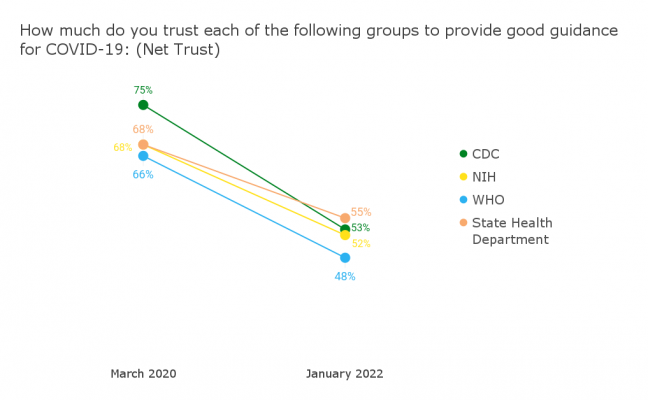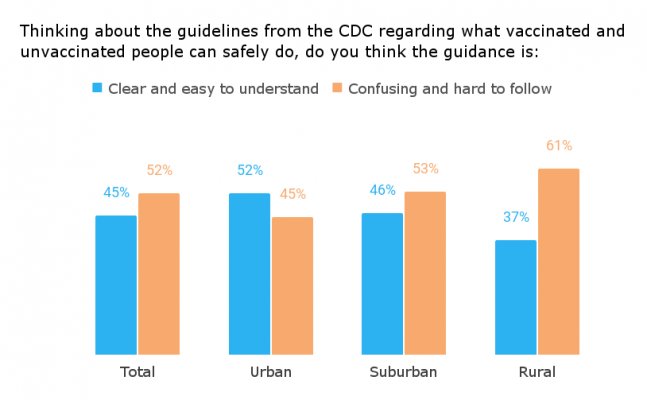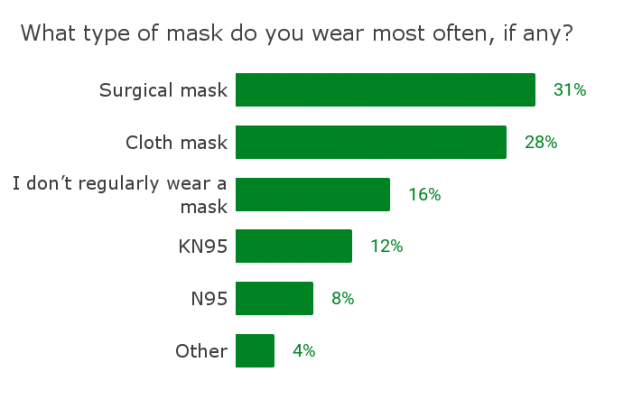Key findings
- Trust in all major U.S. and international health organizations has plummeted since the start of the coronavirus pandemic in March 2020
- Trust has cratered among Republicans and independents; Democrats have as much trust in most health agencies now as they did in 2020
- State health departments had the lowest decay in public trust of all: 68% of people in 2020 and 55% of people now say they trust their state health departments to handle COVID appropriately
- About half (52%) say CDC guidelines regarding what vaccinated and unvaccinated people can safely do are ‘confusing and hard to follow’
- The majority (55%) say the CDC is moving too slowly when it comes to updating the public on new guidelines and recommendations
Trust in all major U.S. and international health organizations has plummeted since the start of the coronavirus pandemic in March 2020, according to a new SurveyMonkey poll.

*Note: in March 2020 we asked “How much do you trust or distrust each of the following to protect Americans from a major outbreak of coronavirus.” and in January 2022 we asked “How much do you trust or distrust each of the following groups to provide good guidance for COVID-19”
The Centers for Disease Control (CDC) began with a high degree of trust but has since fallen 22 percentage points to just 53% now. However, that drop is entirely due to a cratering in trust among Republicans and independents; Democrats have as much trust in the CDC now as they did in 2020.
Net trust in the CDC among:
- Democrats: +1, from 80% to 81%
- Republicans: -48, from 78% to 30%
- Independents: -14, from 64% to 50%
Similarly, trust in the World Health Organization (WHO) dropped 18 percentage points overall from 2020 to now, with a 38 point drop among Republicans (from 60% to 22%) and a 17 point drop among independents (from 58% to 41%). Democrats’ views of the WHO held steady, with 80% saying they trusted the international agency.
The National Institutes of Health (NIH) had mixed gains in public trust as a result of the pandemic. Overall, trust dropped 16 percentage points overall from 2020 to now, with a 43 point drop among Republicans (from 72% to 29%) and an 11 point drop among independents (from 55% to 44%). However, those losses were offset by a seven point increase in trust among Democrats (from 73% to 80%).
State health departments had the smallest decay in public trust: 68% of people in 2020 and 55% of people now say they trust their state health departments to handle COVID appropriately. Trust fell among Republicans from 71% to 43% and among independents from 56% to 50%, in addition to a slight decrease among Democrats (from 75% to 73%).
Increasing distrust comes amid stress and confusion for many seeking guidance from the CDC. About half (52%) say CDC guidelines regarding what vaccinated and unvaccinated people can safely do are ‘confusing and hard to follow.’
- Older adults are least likely to adapt to fluctuating messages: 56% of 35 to 64-year-olds and 52% of those ages 65 and up are unclear about CDC guidelines compared to 46% of 18 to 34-year-olds
- Only a quarter (26%) of Republicans say recommendations are ‘clear and easy to understand’ vs. 52% of Independents and 63% of Democrats
- Just 37% of adults in rural areas say guidelines are ‘clear and easy to understand’ vs. half (52%) of urbanites and 46% of suburbanites
- Unvaccinated adults are more likely to say the CDC’s messaging is unclear and hard to follow compared to those who have been vaccinated (48% vs 66%)

Amid shifting guidelines, adults are split on how satisfied they are with current guidance: 49% say they’re satisfied while 49% are not. The majority (55%) say the CDC is moving too slowly when it comes to updating the public on new guidelines and recommendations. Older adults are particularly conscious of a delay: 61% of adults ages 65 and up say the CDC moves ‘too slowly’ vs. 48% of 18 to 34-year-olds and 56% of 35 to 64-year older adults.
Just 1 in 5 (21%) are following the latest CDC recommendations by regularly wearing N95/KN95 masks. Adherence to this recommendation increases to 32% among Democrats and 30% of adults ages 65 and up. A third (28%) of adults overall regularly wear a cloth mask, and 16% say they don’t wear a mask at all.

Concerns about the virus still remain high as the third year of the pandemic approaches. Almost two-thirds (64%) say they’re worried about a family member being exposed to the virus. About four in 10 (37%) describe the virus as a ‘serious source of stress.’
- Blacks (47%) and Hispanics (46%) are more likely than Asians (39%), whites (32%) and people of other races (37%) to say COVID is a source of serious stress for them
- Women are more likely than men to consider COVID to be a source of serious stress (42% vs. 30%)
- 45% of those with household incomes under $50,000 consider COVID to be a source of serious stress, compared with 36% of people with household incomes from $50,000 to $99,999 and 27% of people with household incomes of $100,000 or more
- Parents of children under 18 are slightly more likely to cite the virus as a ‘serious source of stress’ (40%) compared to those who have children over 18 or aren’t parents (35%).
Read more about our polling methodology here.
Click through all the results in the interactive toplines below:



